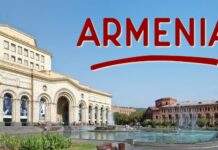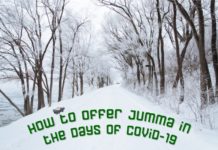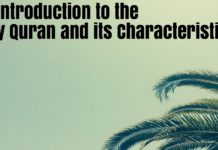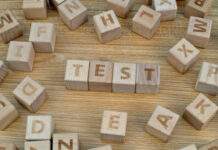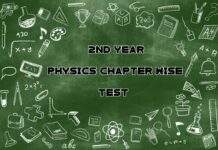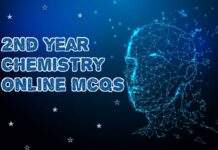Chemistry 2nd Year Chapter wise Test session is available on this website. Teachers and holders of an AQ Academy can give you the opportunity to download a chapter of Chemistry class 12 for a test session. 2nd year chemistry test 1 to 15 chapter here but here I will provide you the FSC part 2 chemistry test chapter for free. I will provide you Online test facility totally free of different subjects.

A.Q ACADEMY
Table of Contents
CHAPTER 1
Chemistry 2nd Year Chapter wise Test
Subject: Chemistry AQ ACADEMY
Class: 2nd Year Marks: 40
| In group i-A charge to size ratio in a group | |||||||
| a | Decrease | b | Increase | c | Remain same | d | None |
| Tin and lead are | |||||||
| a | Insulators | b | Conductors | c | Semi-conductors | d | All |
| Which group elements shows zero oxidation state | |||||||
| a | VIII – A | b | VIII – B | c | VII – A | d | VI – A |
| In SnCl⁴ the oxidation state of Sn is? | |||||||
| a | +2 | b | -2 | c | -4 | d | +4 |
| Nonmetallic character as atomic size increase. | |||||||
| a | Decrease | b | Increase | c | Remain same | d | None |
| Second electron affinity of oxygen is | |||||||
| a | + 141 | b | + 744 | c | -141 | D | -744 |
| Which of the following has highest ionization energy? | |||||||
| a | B | b | C | c | N | d | O |
| Ionic Radius of F- is . | |||||||
| a | 133 pm | b | 72 pm | c | 133 nm | d | 72 nm |
| Which has highest Ionization energy. | |||||||
| a | Mg | b | Mg+ | c | Mg++ | d | None |
| Total periods in periodic table are. | |||||||
| a | 8 | b | 7 | c | 9 | d | 10 |
| Q # 2 | Short Questions | 2X10 = 20 |
- Why the oxidation state very in a period but remain constant in a group ?
- Why d and f – block elements are called transition elements ?
- How lanthanide contraction control the atomic sizes of elements of 6th and 7th periods ?
- Why diamond is a non conductorand graphite is fairly a good conductor .
- Why the second value of electron affinity is shown with positive sign .
- Why atomic radiusdecrease in a period.
- Define hydration energy with example
- Why ionic characters of halidesdecreases from left to right in a period?
- What do you mean by metallic character ?
- Define electron affinity with example.
| Q # 3 | Long Questions | 2 X 5 = 10 |
- Define ionization energy and explain it trends ?
- Explain melting and boiling points with trends .
CHAPTER 2
Chemistry 2nd Year Chapter wise Test
Subject: Chemistry AQ ACADEMY
Class: 2nd Year Marks: 40
| Which of the following is not an alkali metal ? | |||||||
| a | Fr | b | Cs | c | Rb | d | Ra |
| The oxide of berylliumis ? | |||||||
| a | Acidic | b | Baric | c | Amphoteric | d | None |
| The elements calcium bears resemblancewith ? | |||||||
| a | Ca | b | Cr | c | Both | d | None |
| Chile saltphemhas chemical formula | |||||||
| a | NaNo3 | b | KNO2 | c | Na2B4O7 | d | None |
| Minerals caso⁴ 2H²O has the general name | |||||||
| a | Dolomite | b | Gypsum | c | Calcite | d | Epsom salt |
| Down cell is use to prepared | |||||||
| a | Na2 Ca3 | b | NaHCO3 | c | Na metal | d | All |
| Solubility of sulphatesof alkaline earth metals down the group . | |||||||
| a | Decrease | b | Increase | c | Remain same | d | None |
| A saturated solution of in water is called lime water | |||||||
| a | CaO | b | CaCo3 | c | Ca ( OH )2 | d | None |
| Alkaline earth metals show oxidation stake. | |||||||
| a | +1 | b | +2 | c | +3 | d | -2 |
| Chemical formula of barite is . | |||||||
| a | BaSo4 | b | BaCo3 | c | BrSO4 | d | BrCO3 |
| Q # 2 | Short Questions | 10 x 2 = 20 |
- Why alkali metals are called so ?
- Write advantage of commercial preparation of Na metal in down cell .
- WhyBe shows peculiar behavior.
- Draw diagram of down cell ?
- Write formula of Beryl and sylvite .
- What happen when LiOH is heated to red hot ?
- Write reaction on cathode and anodic down cell ?
- How sodium beryllateis produced ?
- Write name of S block elements .
- What happen when LiHis treated with water ?
| Q # 3 | Long Questions | 2×5 = 10 |
- Explain commercial preparation of NaoHby the diaphragm cell?
- Write a note on peculiar behavior of the lithium .
CHAPTER 3
Chemistry 2nd Year Chapter wise Test
Subject: Chemistry AQ ACADEMY
Class: 2nd Year Marks: 40
| Basic acid is ? | |||||||
| a | Weak base | b | Weak acid | C | Strong acid | d | Strong base |
| When basic acid is neutralized by soda ash is formed . | |||||||
| a | H2B4O7 | b | Na2So4 | C | B2O3 | d | None |
| The geometry of H² Bo⁴ is . | |||||||
| a | Triclinic | b | Cubic | C | Tetragonal | d | Hexagonal |
| Chemical formula of acid is | |||||||
| a | H4B9 O6 | b | H3 B5 O8 | c | H6 B4 O9 | d | H4 B6 O9 |
| The hydronic of borax is prevented in the presence of. | |||||||
| a | Glycerin | b | Glycol | c | Glucagon | d | Glucose |
| Common oxidation States of boron are . | |||||||
| a | +3 | b | -3 | c | Both | d | +1 |
| Third most abundant element in earth crust is . | |||||||
| a | Boron | b | Aluminum | c | Oxygen | d | Silicone |
| Which metal is used in the thermite process because of its reactivity ? | |||||||
| a | Iron | b | Copper | c | Aluminum | d | Zine |
| Which element belong to IV – A group of the period table . | |||||||
| a | Barium | b | Lead | c | Oxygen | Jd | Iodine |
| Chief are of aluminum is. | |||||||
| a | AI2 O3 2HO | b | AI2 O5 2HO | c | AI7 O3 2HO | d | None |
| Q # 2 | Short Questions | 10 x 2 = 20 |
- Why boron shows peculiarbehavior ?
- How borax is produced from calumniate ?
- What happen when borax is heated with Nh4 Cl ?
- What do you know about borax bead test ?
- How does borax serve as water softening agent.
- Gives the name and formulas and different acids and boron .
- Give the name electronic configuration of group IV – Aelements.
- How will you convert boric acid into borax and vise versa.
- What is the action of an aqueous solution of borax an litmus.
- How does orthoboricacid react with C2 H5 OH ?
| Q # 3 | Long Questions | 2 X 5 = 10 |
- Explain reaction of aluminum with ear non metals acid and alkaline .
- Write uses of aluminum .
CHAPTER 4
Chemistry 2nd Year Chapter wise Test
Subject: Chemistry AQ ACADEMY
Class: 2nd Year Marks: 40
| Nitrogen and phosphorus give | |||||||
| a | Acidic oxides | b | Basic oxides | c | Amphoteric | d | None |
| Common valenciesof group V-A elementsare . | |||||||
| a | 3 | b | 4 | c | 5 | d | Both a and c |
| Which of the following is laughing gas ? | |||||||
| a | No2 | b | N2O | c | NO | d | N2 O3 |
| Which gas is not combustible but resembles oxygen in rekindling a glowing splinter. | |||||||
| a | N2O | b | NO | c | NO2 | d | N2O5 |
| Which oxide of nitrogen gives ring test . | |||||||
| a | N2O | b | NO | c | NO2 | d | None |
| Complete the reaction.2Pb ( NO3) > 2PbO ? + O2 | |||||||
| a | N2O | b | NO | c | NO2 | d | None |
| Phosphoruscan exit in at least allomorphic forms | |||||||
| a | Two | b | Three | c | Five | d | Six |
| Water contains nearly% oxygen. | |||||||
| a | 50% | b | 89% | c | 14% | d | ¼th |
| Tellurium has allotropicforms . | |||||||
| a | Two | b | Three | c | Five | d | Nine |
| Formula of stibnite is : | |||||||
| a | Sb3 S2 | b | Sb2 S3 | c | Sb4S3 | d | None |
| Q # 2 | Short Questions | 10 x 2 = 20 |
- How does aquaregiadissolve gold and platinum.
- How does nitrogen differ from other element of it’s group?
- The structural formal of NO and N2O3 ?
- Write any method of preparation of NO2 ?
- Which has is called laughing gas and why ?
- What are the oxyacid ofnitrogen and draw their structural formula.
- Write one method of preparation of NHO2.
- How NHO2 act as an oxidizing agent .
- Write uses of NHO3
- What do you about white phosphorus.
| Q # 3 | Long Questions | 2 X 5 = 10 |
- Explain manufacture of sulphuric acid .
2. Explain properties of nitrous acid?
CHAPTER 5
Chemistry 2nd Year Chapter wise Test
Subject: Chemistry AQ ACADEMY
Class: 2nd Year Marks: 40
| Which hydrogen halides is the weakest acid in solution. | |||||||
| a | HF | b | HCl | C | HBr | d | HI |
| The anhydride ofHCl⁴ . | |||||||
| a | ClO3 | b | ClO2 | C | Cl2 O5 | d | Cl2 O7 |
| Which is the strongest acid . | |||||||
| a | HClO | b | CIO2 | C | HClO3 | d | HClO4 |
| Which halogen occurenaturally in positive oxidation State. | |||||||
| a | Iodine | b | Bromine | C | Chlorine | d | Fluorine |
| Hydrogen bonds is the strongest between the molecules of. | |||||||
| a | HF | b | HCl | C | HBr | d | HI |
| Which of the following is halite. | |||||||
| a | KCl | b | NaCl | c | CsCl | d | KBr |
| The order of decreasing power as an oxidizing agent is : | |||||||
| a | Cl2>F2> I 2 Br2 | b | F2>Br2>Cl2>I2 | c | I2>Br2>Cl2>F2 | d | F2>Cl2>Br2>I2 |
| Which can oxidize various coloured dyes to colourless substances. | |||||||
| a | F2 | b | Cl2 | c | Br2 | d | A and B |
| HF is : | |||||||
| a | Solid | b | Liquid | c | Gas | d | Plasma |
| Which is used for quantitative analysis of CO. | |||||||
| a | I2O5 | b | I2O4 | c | I4O9 | d | All |
| Q # 2 | Short Questions | 10 x 2 = 20 |
- What are the disproportionationreaction give examples?
- Why halogens gain electron readily ?
- Why does fluorine shows peculiar behavior ?
- Fluorine remainrestricted to -1 oxidation State.
- Under what condition does aluminium corrode?
- On which factors does the oxidizing power of halogen depends ?
- What do you about CI2 O7?
- What is per chloric acid ?
- Why per chloric acid is used as 67% solution in water?
- Why HF is weaker acid then HI ?
| Q # 3 | Long Questions | 2 X 5 = 10 |
- Write Beckmann’s method for preparation of bleaching powder .
- Explain properities of halogen halides.
CHAPTER 6
Chemistry 2nd Year Chapter wise Test
Subject: Chemistry AQ ACADEMY
Class: 2nd Year Marks: 40
| Valency shown by transition elements. | |||||||
| a | 1 | b | 2 | c | 3 | d | Variable |
| Paramagnetic behavior is strongest for : | |||||||
| a | Fe³+ | b | Mn²+ | c | Both | d | None |
| Cavalent radii rapidly at start of series : | |||||||
| a | Decrease | b | Increase | c | Remain same | d | All |
| In first transition series increase in binding energy ends at : | |||||||
| a | V | b | Mn | c | Zn | d | Cu |
| Which oxidation stake is shown by all elements of first transition series ? | |||||||
| a | +1 | b | +2 | c | +3 | d | +4 |
| The solution of [To ( H2O )6] ³+ looks in colour : | |||||||
| a | Yellow | b | Pink | c | Violet | D | Blue |
| Group VI – B of transition elements contain : | |||||||
| a | Zn,Cd,Hg | b | Cr,Mo,w | c | Mn,Te,Re | d | None |
| Which is non typicaltransition elements: | |||||||
| a | Cr | b | Mn | c | Fe | d | Zn |
| Which is a typical transition element: | |||||||
| a | Sc | b | Y | c | Re | d | Co |
| The strength of binding energy of transition elements depends upon : | |||||||
| a | Number of electron pairs | b | Number of neutrons | c | Number of unpaired electron | d | None |
| Q # 2 | Short Questions | 10 x 2 = 20 |
- Define corrosion ?
- What do you know about cathode coating ?
- What are interstitial compounds ?
- What do you know about typical and non typical transition elements ?
- What are substitutionalalloys ?
- Write some properties of transition elements .
- How the process of galvanizing protect iron from rusting ?
- What is meant by d-d transition ?
- How corrosion can be prevented ?
- What are the outer transition elements?
| Q # 3 | Long Questions | 2 X 5 = 10 |
- Explain electrochemical theory.
- Write about the general characteristics of transition elements.
- Binding energies 2) Para magnetism. 3) oxidation State. 4) covalent and ionic radii.
CHAPTER 7
Subject: Chemistry AQ ACADEMY
Class: 2nd Year Marks: 40
| The chemist who synthesizedurea from ammonium cyanate was : | |||||||
| a | Kolbe | b | Wholer | c | Lavoisioner | d | None |
| A double consist of : | |||||||
| a | Two pi bonds | b | Two sigma | c | One sigma one pi | d | None |
| Select which one is alcohol : | |||||||
| a | C2H5 OH | b | CH3-O-CH3 | c | CH3COOH | d | All |
| Linear shape is associated with hybridization : | |||||||
| a | Sp3 | b | Sp2 | c | Sp | d | dsp |
| Which set of hybrite orbital has triangle shape: | |||||||
| a | Sp3 | b | Sp2 | c | Sp | d | d2Sp3 |
| State of hybridization in CH4 is : | |||||||
| a | Sp3 | b | Sp2 | c | Sp | d | d2Sp3 |
| Ethers and alcohol show isomerism : | |||||||
| a | Tautomerism | b | Functional group | c | Both | d | None |
| The diagram represent which compound : | |||||||
| a | Pyridine | b | Thiophene | c | Pyrrole | d | Furan |
| Saturated alicyclic hydrocarbon have general formula : | |||||||
| a | CnH 2n +1 | b | CnH2n | c | CnH 2n-2 | d | None |
| Organic compounds are in water : | |||||||
| a | Insoluble | b | Soluble | c | Both | d | None |
| Q # 2 | Short Questions | 10 x 2 = 20 |
- Define catenation ?
- What is vital force theory.
- What do you mean by reforming ?
- What are alicyclic compounds ?
- Define functional groups give examples .
- Write two features of organic compounds.
- Define tautomerismand give examples.
- What is cistransisomerism.
- Why there is no free rotation around a double bound .
- Define isomerism .
| Q # 3 | Long Questions | 2 X 5 = 10 |
- Explain sphybridization with examples.
- Explain cracking and it’stypes.
CHAPTER 8
Subject: Chemistry AQ ACADEMY
Class: 2nd Year Marks: 40
| For alkanes with more carbon atoms the root word is derived from the greek or Latin : | |||||||
| a | 3 | b | 4 | c | 5 | d | 1 |
| Alkanes also called : | |||||||
| a | Olefins | b | Paraffin’s | c | Acetylene | d | None |
| IUPAC names of H2C =CH-CH=CH2 is : | |||||||
| a | 2,4- butadiene | b | 1,4-butadiene | c | 2,3-butadiene | d | None |
| Hydrogen lysis can be carried out in presence of : | |||||||
| a | Pt/charcoal | b | Pcl- charcoal | c | Ni | d | None |
| Formula of chloroform: | |||||||
| a | CH3Cl | b | CCl4 | c | CH2 Cl2 | d | CHCl3 |
| Synthetic rubber is made by polarization of : | |||||||
| a | Chloroform | b | CH=CH | c | Chloroprene | D | None |
| B-Bdichloroethlysulphideis commonly known as : | |||||||
| a | Mustard gas | b | Laughing gas | c | Phosgene gas | d | None |
| The presence of double bond in compound in sign of : | |||||||
| a | Saturation | b | Unsaturation | c | Substitution | d | None |
| Which is used for artificial ripening of fruits: | |||||||
| a | Ethene | b | Ethyne | c | Methane | d | Propane |
| Beparation of vegetables ghee involves : | |||||||
| a | Hologenation | b | Hydrogenation | c | Both | d | None |
| Q # 2 | Short Questions | 10 x 2 = 20 |
- Write IUPAC names of the following.
- CH3 CH2 ( CH3 )² CH ( CH2 CH3) CH3
- ( CH3 )² CH- CH –CH ( CH3)²CH³
- Compare the reactivities alkanes alkenes ,alkynes .
- Prepare oxalic acid from ethyne.
- What is hydration reaction of alkynes.
- How ethyne is prepared from dehydroholgenationof vicinal dihalidie.
- Why alkenes are so reactive .
- Prepare alkenes from hydration of alcohols.
- What is Clemensonreduction.
- Identify A and B ?C3H7OH >PCl5 A Na >B .
- Convert 1- butuneto 1-Bytune.
| Q # 3 | Long Questions | 2 X 5 = 10 |
- Explain halogenation alkanes and explain it step by step.
- Explain acidity of alkynes .
CHAPTER 9
Subject: Chemistry AQ ACADEMY
Class: 2nd Year Marks: 40
| C-C bond length in benzene is : | |||||||
| a | 1-397 Å | b | 1.54 Å | c | 1.34Å | d | None |
| Geometry benzene is : | |||||||
| a | Cubic | b | Tetragonal | c | Hexagonal | d | None |
| Benzene was discovered by Michael Faraday in : | |||||||
| a | 1852 | b | 1825 | c | 1952 | d | 1925 |
| Name of this compounds : | |||||||
| a | Naphthalene | b | Anthraces | c | Phenanthrene | d | None |
| By distilling phenol with zinc dust is prepared : | |||||||
| a | Xylene | b | Toluene | c | Bromobenzen | d | Benzene |
| Which of the following can be used as catalyst in fridal craft reaction: | |||||||
| a | AlCl3 | b | HNo3 | c | BeCl3 | D | NaCl |
| Aromatics hydrocarbon are the derivatives of : | |||||||
| a | Alkene | b | Benzene | c | Cyclohexane | d | None |
| During nitration of benzene the active nitrating agent is : | |||||||
| a | No3 | b | No+2 | c | No2 | d | HNo3 |
| Electrophile in aromatic salphonation is : | |||||||
| a | H2So4 | b | HSŌ4 | c | SO3 | d | None |
| The conversation of n-hexane into benzene by heating in the presence of pt is called: | |||||||
| a | Isomerization | b | Aromatization | c | Dealkylation | d | None |
| Q # 2 | Short Questions | 10 x 2 = 20 |
- What is side chain oxidation benzene.
- How malicacid in prepared benzene.
- Write mechanism for nitration of benzene.
- Write mechanism for salphunation of benzene.
- Prepare benzyl chloride from toluene .
- What is wurtz – fitting reaction.
- Convert acetylene to benzene.
- What are resonance structure.
- What is meant by resonance energy.
- Prepare benzene from n Hexane.
| Q # 3 | Long Questions | 2 X 5 = 10 |
- Explain orientation in electrophilic substitution reaction.
- Explain Friedel craft+ Alkylation and acylation.
CHAPTER 10
Subject: Chemistry AQ ACADEMY
Class: 2nd Year Marks: 40
| CH3 \CH –Cr is /CH3 | |||||||
| a | Primary alkylhalide | b | Secondary | c | Tertiary | d | None |
| Alkyl halides can be prepared by the : | |||||||
| a | Halogenation of alkanes | b | Halogenation of alkenes | c | Halogenation alkynes | d | None |
| Those reaction of alkyl halides which in involve the removal of Hxfrom alkyl halide : | |||||||
| a | Elimination reaction | b | Substitution reaction | c | Both | d | None |
| Iodide ion is a good nucleophile as well as : | |||||||
| a | Bad leaving group | b | Good leaving group | c | Both | d | None |
| In primary alkyl halide the halogen atom is attached to a carbon atom which is attached to carbon atom : | |||||||
| a | 2 | b | 3 | c | 4 | d | 1 |
| When CO2 made to react with ethyl magnesium iodide : Followed by acid hydrolysis the protect is : | |||||||
| a | C3H8 | b | CH3CH2 COOH | c | CH3 CH2 CH2OH | D | None |
| Which is nota nucleophile : | |||||||
| a | H2O | b | H2S | c | BF3 | d | NH3 |
| E2 reaction shows order : | |||||||
| a | 1 | b | 2 | c | 3 | d | 4 |
| Primary alkyl halides follow: | |||||||
| a | Sn2 | b | SN1 | c | Both | d | None |
| Carbocation is intermediate is formed in : | |||||||
| a | SN2 | b | E2 | c | SN1 | d | None |
| Q # 2 | Short Questions | 10 x 2 = 20 |
- What are the tertiary alkylhalides. 2 Write method of preparation of alkyl iodide .
- Define nucleophile . 4. What is leaving group.
- Howethylethioalcoholis prepared from bromoethene.
- Write reaction of methyl and ethyl chloride with Na⁴ pb ?
- What do you mean by wurtzsynthesis?
- Write any method of preparation of alkyl halide from alcohol.
- How ( CH3 – CH2 ) N+ is produced from CH3 – CH2 – Br ?
- Write IUPAC names.
a)H2C _ CH2 b) ( CH3 ) C- CH – Cl
| |
Br Br
| Q # 3 | Long Questions | 2 X 5 = 10 |
1. Explain SN1 reaction and mechanism?
2. Explain ß- elimination reaction?
Buy The Related Books Suggested By Experts
Subject: Chemistry AQ ACADEMY
Class: 2nd Year Marks: 40
| Alcohol and phenol are considered as hydroxyl derivative of : | |||||||
| a | Alkanes | b | Benzene | c | Both | d | Alkenes |
| Contains two three or more or OH group: | |||||||
| a | Monohydric | b | Polyhydric alcohol | c | Both | d | None |
| Optimum temperature for fermentation is : | |||||||
| a | 20-35⁰ C | b | 25-30⁰ C | c | 25-35⁰C | d | None |
| Alcohol obtained by fermentation is only: | |||||||
| a | 10% | b | 11% | c | 12% | d | 13% |
| If a nucleophile attacks which bond break : | |||||||
| a | C-O | b | O-H | c | C-H | d | None |
| Alcohol are resistant to oxidation : | |||||||
| a | Primary | b | Tertiary | c | Secondary | D | All |
| Which enzyme is not involved in the fermentation of starch : | |||||||
| a | Diastase | b | Enzyme | c | Urease | d | Invertase |
| Which compound have maximum repulsion with water ? | |||||||
| a | C6H6 | b | C2H5 OH | c | CH3 CH2 CH2 OH | d | All |
| Which compound shows hydration bonding : | |||||||
| C2H6 | b | C2H5 Cl | c | CH3-O-CH3 | d | C2 H3 OH | |
| 10 CH2 – CH2 is named as : | | OH OH | |||||||
| a | Glycerol | b | Glycerin | c | Glucagon | d | Glycol |
| Q # 2 | Short Questions | 10 x 2 = 20 |
- What is dow,smethod?
- Write physical properties of phenol ?
- Why phenol is acidic ?
- What is Lucastest ?
- Why productsof dehydrationof alcohol at different temperature .
- Which products is formed when tertiary alcohol is oxidize .
- Wnkorder of reactivity of alcohol when O-H and C-O bond breaks .
- What is Nitration of phenol .
- Prepare Oster from phenol.
- Differentiate between ethanol and methanol with the help of a test .
| Q # 3 | Long Questions | 2 X 5 = 10 |
- Write reaction in which C-O and O-H bond breaks .
- Explain reaction of phenol due to benzene ning .
CHAPTER 12
Subject: Chemistry AQ ACADEMY
Class: 2nd Year Marks: 40
| ____ group is present camphor : | |||||||
| a | Aldehyde | b | Ketonic | c | Carboxylic | d | Alcohol |
| ____ is prepared by the distillation of calcium acetate : | |||||||
| a | Propanone | b | Butanone | c | Acetone | d | Both A+C |
| Reaction is used to separatecarbonyl compounds from non carbonyl compounds: | |||||||
| a | Addition of Grignard reagent | b | Addition of HCl | c | Addition of sodiumbisulphite | d | None |
| Sodium nitroprusside is shown by : | |||||||
| a | Ketone | b | Aldehyde | c | Alcohol | d | None |
| Aldehyde the first oxidation product of : | |||||||
| a | Primary alcohol | b | Secondary alcohol | c | Tertiary alcohol | d | Quaternary |
| The carbon atom is carbonyl group is : | |||||||
| a | Sp-hybridized | b | Sp3 | c | Sp2 (d) none | ||
| Which is the highest boiling point : | |||||||
| a | CH3– OH | b | Ethanol | c | Propanone | d | 2-hexanone |
| Formalin in : | |||||||
| a | 10% water | b | 40% formaldehyde | c | Both | d | None |
| Aldehyde are strong agent : | |||||||
| a | Reducing | b | Oxidizing | c | Both | d | None |
| 10. C6 H5 -C”⁰-CH3 is : | |||||||
| a | Butanone | b | 2-heptanone | c | Acetophenone | d | None |
| Q # 2 | Short Questions | 10 x 2 = 20 |
- What is iodoformtest ?
- How metafomaldehydeandparaldehyde is produced .
- How acetone 2,4- DNPH is produced .
- Write four uses of Acetaldehyde .
- What is tollen,s test ?
- What do you know about oxidation of ketones .
- Write mechanism of reduction with sodium borohydride.
- Write mechanism of the reaction with ammonia derivative.
- Write mechanism of reaction with sodium bisulphite.
- What is cannizaro,sreaction.
| Q # 3 | Long Questions | 2 X 5 = 10 |
- Explain Aldalcondensation .
- Explain haloform reaction.
CHAPTER 13
Subject: Chemistry AQ ACADEMY
Class: 2nd Year Marks: 40
| Chemical formula of stearic acid : | |||||||
| a | C17 H34 COOH | b | C18 H35 COOH | c | C17 C34 COOH | d | None |
| The irritation caused by an ant bite is due to : | |||||||
| a | Formic acid | b | Acetic acid | c | Propionic acid | d | All |
| Hydrolysis of an alkene atrial on heating with a mineral acid or alkalis yield. | |||||||
| a | Aldehyde | b | Ketone | c | Alcohol | d | Carboxylic acid |
| Malting point of botanic acid is : | |||||||
| a | –22⁰ C | b | -6⁰C | c | -36⁰C | d | –18⁰C |
| What is the flavour of Amy lactate : | |||||||
| a | Apple | b | Banana | c | Apricot | d | None |
| Carboxylic acid an reduction with red phosphorus give: | |||||||
| a | Alkanes | b | Alkenes | c | Alcohol | D | Alkynes |
| Which is not a fatty acid : | |||||||
| a | Propionic acid | b | Acetic acid | c | Phthalic acid | d | None |
| Which acid is used in the manufacture of synthetic fiber : | |||||||
| a | Formic acid | b | Oxalic acid | c | Carbonic acid | d | None |
| Which reagent is used to reduce a carboxylic group to an alcohol : | |||||||
| a | H2/Ni | b | H2/pt | c | NaBH4 | d | LiAlH4 |
| Acetic acid manufactured by : | |||||||
| a | Distillation | b | Fermentation | c | Zonolysis | d | All |
| Q # 2 | Short Questions | 10 x 2 = 20 |
- What do you know about the boiling points of carboxylic acids.
- How carboxylic react with carbonates .
- How carboxylic acid is prepared by hydrolysis of ester .
- Prepare carboxylic acid from Grignard reagent.
- Which compound produced by oxidative cleavage of alkenes.
- Write mechanism of reaction of carboxylic acids with SOCl2.
- Write four uses of acetic acid.
- Prepare acetic acid on industrial scale from acetylene.
- Write physical properties of acetic acid.
- How acetic anhydride is produced.
| Q # 3 | Long Questions | 2 X 5 = 10 |
- Explain mechanism of formation of Easter.
- Explain mechanism of formation of amide
CHAPTER 14
Subject: Chemistry AQ ACADEMY
Class: 2nd Year Marks: 40
| Which elements are needed for healthy growth of plants. | |||||||
| a | N,S,P | b | N,Ca,P | c | N,P,K | d | N,K,C |
| The nitrogen present in some fertilizer helps plant. | |||||||
| a | To fight again disease | b | To produce protein | c | To produce fat | d | To undergo photosynthesis |
| Phosphorus helps growth . | |||||||
| a | Root | b | Leaves | c | Stem | d | Seed |
| Micro nutrients are required in quantity ranging from : | |||||||
| a | 4-40g | b | 6-200g | c | 6-200kg | d | 4-40kg |
| Which is not a calcarious materials : | |||||||
| a | Clay | b | Lime | c | Marble | d | Marine shell |
| Through how many zones does the charge pass in rotany kiln : | |||||||
| a | 4 | b | 3 | c | 2 | D | 5 |
| For which crop ammonium nitrate fertilizer is not used ? | |||||||
| a | Cotton | b | Wheat | c | Sugar can | d | Paddy rice |
| The temperature of decomposition zone goes upto : | |||||||
| a | 600⁰C | b | 900⁰C | c | 1000⁰C | d | 1200⁰C |
| Ammonia contains % nitrogen: | |||||||
| a | 82% | b | 33-33.5% | c | 46.46% | d | None |
| Manure is an material used to fertilize land : | |||||||
| a | Plant | b | Animal | c | Fungus | d | None |
| Q # 2 | Short Questions | 10 x 2= 20 |
- Differentiate between macro nutrients and micro nutrients.
- What are good qualities of good fertilizer.
- What is cement?
- What do you know about ammonia as fertilizer.
- What are raw material used for manufacture of cement.
- What do you know about potassium fertilizer.
- What is prilling?
- What do you know about diammoniumphosphate.
- Write composition of cement.
- What is slurry .
| Q # 3 | Long Questions | 2 X 5 = 10 |
- Explain manufacturing of urea .
- Explain manufacturing of cement.



